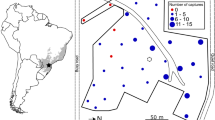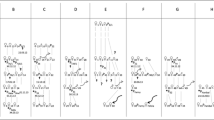Abstract
We examined gender-dependent competitive interactions between two nocturnal desert gerbil species, Gerbillus andersoni allenbyi and G. pyramidum, by a field manipulation experiment. The study was done in two 1-ha enclosed plots and included allopatric (only G. a. allenbyi) and sympatric (both species together) treatments. Seed trays and thermal imaging cameras were used to observe the gerbils’ foraging activities and aggressive interactions. We found that the negative effect of the competitively dominant species, G. pyramidum, on time spent in seed trays, and ability to control these artificial food patches, was stronger on male than on female G. a. allenbyi. Consequently, the aggression of male G. a. allenbyi towards female G. a. allenbyi was markedly reduced, indicating that the dominant species mediated competition between the genders of the subordinate species. Furthermore, this interference-mediated indirect effect was associated with a decrease in the body mass of male G. a. allenbyi and an increase in the survival of female G. a. allenbyi. We suggest that both the reduction in intra-specific aggression and the positive effect on female survival can potentially stabilize competitive interactions and promote coexistence in this small mammal community.




Similar content being viewed by others
References
Abrams PA, Menge BA, Mittelbach GG, Spiller DA, Yodzis P (1996) The role of indirect effects in food webs. In: Polis GA, Winemiller KO (eds) Food webs: integration of patterns and dynamics. Chapman and Hall, New York, pp 371–395
Abramsky Z (1984) Population biology of Gerbillus allenbyi in northern Israel. Mammalia 48:197–206
Abramsky Z, Brand S, Rosenzweig ML (1985a) Geographical ecology of gerbilline rodents in sand dune habitats of Israel. J Biogeogr 12:363–372
Abramsky Z, Rosenzweig ML, Brand S (1985b) Habitat selection of Israel desert rodents: comparison of a traditional and a new method of analysis. Oikos 45:79–88
Abramsky Z, Rosenzweig ML, Pinshow B, Brown JS, Kotler BP, Mitchell WA (1990) Habitat selection: an experimental field test with two gerbil species. Ecology 71:2358–2369
Abramsky Z, Rosenzweig ML, Pinshow B (1991) The shape of a gerbil isocline measured using principles of optimal habitat selection. Ecology 72:329–340
Abramsky Z, Rosenzweig ML, Subach A (1992) The shape of a gerbil isocline: an experimental field study. Oikos 63:193–199
Abramsky Z, Ovadia O, Rosenzweig ML (1994) The shape of a Gerbillus pyramidum (Rodentia: Gerbillinae) isocline: an experimental field study. Oikos 69:318–326
Alcock J (2001) Animal behaviour: an evolutionary approach, 7th edn. Sinauer, Sunderland, Mass.
Bar Y, Abramsky Z, Gutterman Y (1984) Diet of gerbilline rodents in the Israeli Desert. J Arid Environ 7:371–376
Beckerman AP, Uriarte M, Schmitz OJ (1997) Experimental evidence for a behaviour-mediated trophic cascade in a terrestrial food chain. Proc Natl Acad Sci U S A 94:10735–10738
Brand S, Abramsky Z (1987) Body masses of gerbilline rodents in sandy habitats of Israel. J Arid Environ 12:247–253
Brown JS, Kotler BP, Mitchell WA (1994) Foraging theory, patch use, and the structure of a Negev desert granivore community. Ecology 75:2286–2300
Caswell H (1989) Matrix population models. Sinauer, Sunderland, Mass.
Connell JH (1983) On the prevalence and relative importance of interspecific competition: evidence from field experiments. Am Nat 122:661–696
Cushing JM, Li J (1992) The dynamics of a size-structured intraspecific competition model with density dependent juvenile growth rates. In: DeAngelis DL, Gross LJ (eds) Individual-based models and approaches in ecology: populations, communities and ecosystems. Chapman and Hall, New York, pp 112–125
Danin A (1978) Plant species diversity and plant succession in a sandy area in the Northern Negev. Flora 167:409–422
Davidson DW, Inouye RS, Brown JH (1984) Granivory in a desert ecosystem: experimental evidence for indirect facilitation of ants by rodents. Ecology 65:1780–1786
Degen AA (1996) Ecophysiology of small desert mammals: adaptations of desert organisms. Springer, Berlin Heidelberg New York
von Ende CN (2001) Repeated-measures analysis: growth and other time-dependent measures. In: Scheiner SM, Gurevitch J (eds) Design and analysis of ecological experiments, 2nd edn. Oxford University Press, New York, pp 134–157
Goldberg DE, Barton AM (1992) Patterns and consequences of interspecific competition in natural communities: a review of field experiments with plants. Am Nat 139:771–801
Gurevitch J, Morrow LL, Wallace A, Walsh JS (1992) A meta-analysis of competition in field experiments. Am Nat 140:539–572
Holt RD (1977) Predation, apparent competition, and the structure of prey communities. Theor Popul Biol 12:197–229
Holt RD (1984) Spatial heterogeneity, indirect interactions, and the coexistence of prey species. Am Nat 124:377–406
Huntingford FA, Turner AK (1987) Animal conflict. Chapman and Hall, London
Kotler BP, Brown JS, Hasson O (1991) Factors affecting gerbil foraging behaviour and rates of owl predation. Ecology 72:2249–2260
Kotler BP, Blaustein L, Brown JS (1992) Predator facilitation: the combined effect of snakes and owls on the foraging behaviour of gerbils. Ann Zool Fenn 29:199–206
Kotler BP, Brown JS, Mitchell W (1993a) Environmental factors affecting patch use in two species of gerbilline rodents. J Mammal 74:614–620
Kotler BP, Brown JS, Slotow RH, Goodfriend WL, Strauss M (1993b) The influence of snakes on the foraging behaviour of gerbils. Oikos 67:309–316
Kotler BP, Brown JS, Subach A (1993c) Mechanisms of species coexistence of optimal foragers: temporal partitioning by two species of sand dune gerbils. Oikos 67:548–556
Kotler BP, Ayal Y, Subach A (1994) Effects of predatory risk and resource renewal on timing of foraging activity in a gerbil community. Oecologia 100:391–396
Manly BFJ (1997) Randomization, bootstrap and Monte Carlo methods in biology, 2nd edn. Chapman and Hall, New York
Menge BA (1995) Indirect effects in marine rocky intertidal interaction webs: patterns and importance. Ecol Monogr 65:21–74
Morrison LW (1999) Indirect effects of phorid fly parasitoids on the mechanisms of interspecific competition among ants. Oecologia 121:113–122
Ovadia O (1999) Integrating behavioural responses of individual Gerbillus allenbyi and G. pyramidum (Rodentia: Gerbillinae) with their measured population responses. PhD thesis. Ben-Gurion University of the Negev, Israel
Rosenzweig ML (1991) Habitat selection and population interaction: the search for mechanism. Am Nat 137:S5–S28
Schoener TW (1983) Field experiments on interspecific competition. Am Nat 122:240–285
Sih A, Krupa JJ (1996) Direct and indirect effects of multiple enemies on water strider mating dynamics. Oecologia 105:179–188
Takenaka Y, Matsuda H, Iwasa Y (1997) Competition and evolutionary stability of plants in a spatially structured habitat. Res Popul Ecol 39:67–75
Tuljapurkar S, Caswell H (1996) Structured-population models. Chapman and Hall, New York
Werner EE (1991) Nonlethal effects of a predator on competitive interactions between two anuran larvae. Ecology 72:1709–1720
Werner EE (1992) Individual behaviour and higher-order species interactions. Am Nat 140:S5–S32
Werner EE (1994) Ontogenetic scaling of competitive relations: size-dependent effects and responses in two anuran larvae. Ecology 75:197–213
Werner EE, Gilliam JF (1984) The ontogenetic niche and species interactions in size-structured populations. Annu Rev Ecol Syst 15:393–425
Wootton JT (1992) Indirect effects, prey susceptibility, and habitat selection: impacts of birds on limpets and algae. Ecology 73:981–991
Yodzis P (1988) The indeterminacy of ecological interactions as perceived through perturbation experiments. Ecology 69:508–515
Ziv Y, Abramsky Z, Kotler BP, Subach A (1993) Interference competition and temporal and habitat partitioning in two gerbil species. Oikos 66:237–246
Acknowledgements
We thank Oswald Schmitz, David Skelly, Shimon Anisfeld, Heinrich zu Dohna, Catherine Burns, Andrew Richardson, Michael Booth, Erica Crespi and Mark Urban for discussions and comments on early drafts of this manuscript. Field research was supported by the Israel Science Foundation grant no. 169/95 to Z. A. and B. P. O. O. was supported by a Clore Scholarship (a project of the Charles Clore 1979 Israel Foundation).
Author information
Authors and Affiliations
Corresponding author
Rights and permissions
About this article
Cite this article
Ovadia, O., Abramsky, Z., Kotler, B.P. et al. Inter-specific competitors reduce inter-gender competition in Negev Desert gerbils. Oecologia 142, 480–488 (2005). https://doi.org/10.1007/s00442-004-1726-9
Received:
Accepted:
Published:
Issue Date:
DOI: https://doi.org/10.1007/s00442-004-1726-9




